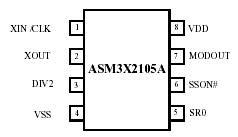ASM3X2105A: Features: *FCC approved method of EMI attenuation.*Generates a 1X or ½ X low EMI spread spectrum clock of the input frequency.*Input frequency range: 6MHz to 10 MHz.*Internal loop filter mini...
floor Price/Ceiling Price
- Part Number:
- ASM3X2105A
- Supply Ability:
- 5000
Price Break
- Qty
- 1~5000
- Unit Price
- Negotiable
- Processing time
- 15 Days
SeekIC Buyer Protection PLUS - newly updated for 2013!
- Escrow Protection.
- Guaranteed refunds.
- Secure payments.
- Learn more >>
Month Sales
268 Transactions
Payment Methods
All payment methods are secure and covered by SeekIC Buyer Protection PLUS.

 ASM3X2105A Data Sheet
ASM3X2105A Data Sheet







